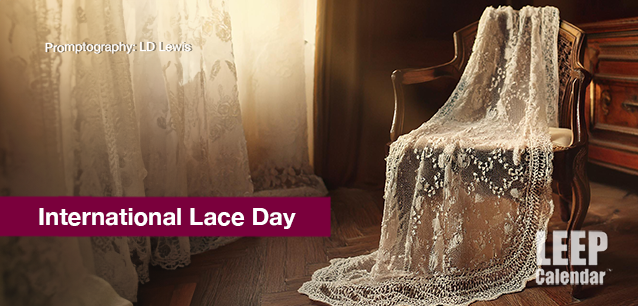 AD
AD
Today is: December 25
Scroll to explore events active on this date.
Additional Events on LEEP
LEEP INK FEATURES

August? Absolutely!
In August, we live through the Dog Days of Summer. It's hot and often humid, and those who can leave for better climates do. Down south, winter is in full force. August is also known as "the ...

In The Heat of July: July 2025 Events
Is it hot enough (or cold enough if you're below the equator) for you yet? There is actually a day for that! Like every month, I pick a diverse collection of events you may or may not know about. This ...

May Blooms: Events in May 2025
Along with October, May is one of the most densely packed months of the year. It's before the summer humidity and the last whole month of the school year. The weather is warming in t...
About International Lace Day
Lifestyle , Hobby
Ends: Sep 27, 2025
DESCRIPTION:
A TOUCH OF GLAMOUR:
INTERNATIONAL LACE DAY
International Lace Day is a celebration dedicated to the art and craft of lace-making, an intricate textile tradition with a rich history. Observed annually on the last Sunday in September, this event aims to bring together lace enthusiasts worldwide to share their passion for lace-making, showcase their skills, and promote the preservation of this delicate craft.
Lace-making communities, guilds, and enthusiasts passionate about keeping this traditional craft alive champion the event. While there is no single organization behind International Lace Day, it has grown organically through the efforts of various lace guilds, crafters, and online communities who organize events, workshops, and exhibitions to mark the day.
Participants in International Lace Day engage in a variety of activities. Many lace-makers gather in person or virtually to work on their projects, exchange techniques, and share their knowledge with others. Some host lace-making demonstrations or open their studios to the public, offering hands-on experiences for those interested in learning more about the craft. Social media also plays a significant role, with participants sharing their lace creations and techniques using specific hashtags to connect with a global audience.
HISTORY OF LACE
Lace is a decorative openwork fabric originating in Europe during the late 15th and early 16th centuries. Its origins are somewhat disputed, but Italy and Belgium are often credited as lace-making birthplaces. Initially, lace was made by hand using delicate threads of linen, silk, or gold, and it quickly became a symbol of luxury and status, often adorning the garments of royalty and the wealthy.
Lace-making involves creating intricate designs by creating patterns of holes in the fabric held together by threads. The craft spread across Europe, with different regions developing unique styles and techniques. By the 17th century, lace had become a highly prized commodity, and lace-makers were regarded as skilled artisans.
Throughout history, lace has been used in various ways. It has traditionally been used to embellish clothing, particularly in collars, cuffs, and veils. Lace is also used in home décor, such as tablecloths, curtains, and bed linens. In modern times, lace remains popular in fashion, especially in bridal wear, lingerie, and evening gowns, whose delicate and intricate patterns add an element of elegance and sophistication.
STYLES OF LACE
Over the centuries, a rich tapestry of distinct lace styles has evolved, each with its own unique characteristics and regional significance. This diversity within the craft is a testament to the creativity and ingenuity of lace-makers.
—Bobbin Lace:
This style, made by braiding and twisting threads wound on bobbins, originated in Italy and spread to other parts of Europe. It is known for its fine, delicate patterns.
—Needle Lace:
This style, created using a needle and thread, is one of the oldest forms of lace-making. It involves stitching the pattern into a base fabric and cutting away the background.
—Chantilly Lace:
Originating in France, Chantilly lace is known for its delicate floral patterns and is often used in bridal and evening wear.
—Irish Crochet Lace:
Developed in Ireland during the 19th century, this lace is made using a crochet hook and is known for its raised three-dimensional designs.
—Brussels Lace:
Hailing from Belgium, this style uses a combination of bobbin and needle lace techniques, resulting in intricate and often floral designs.
International Lace Day celebrates the beauty and craftsmanship of lace and reminds us of the cultural heritage and history associated with this delicate art form. By bringing together lace makers and enthusiasts from around the world, the event helps ensure that the tradition of lace-making continues to be cherished and passed down through generations.
VIDEOS
SUPPORTING DOCUMENTS
Currently, this event does not have supporting documents.
ADDITIONAL IMAGES
Currently, this event does not have supporting images.
Where would you like to go now?
 AD
AD


/footer-logo.svg)
